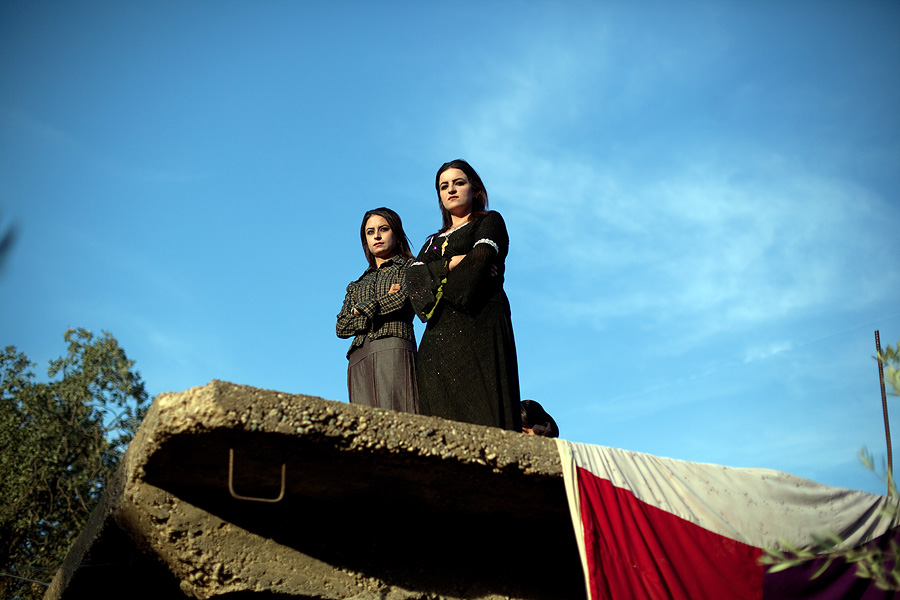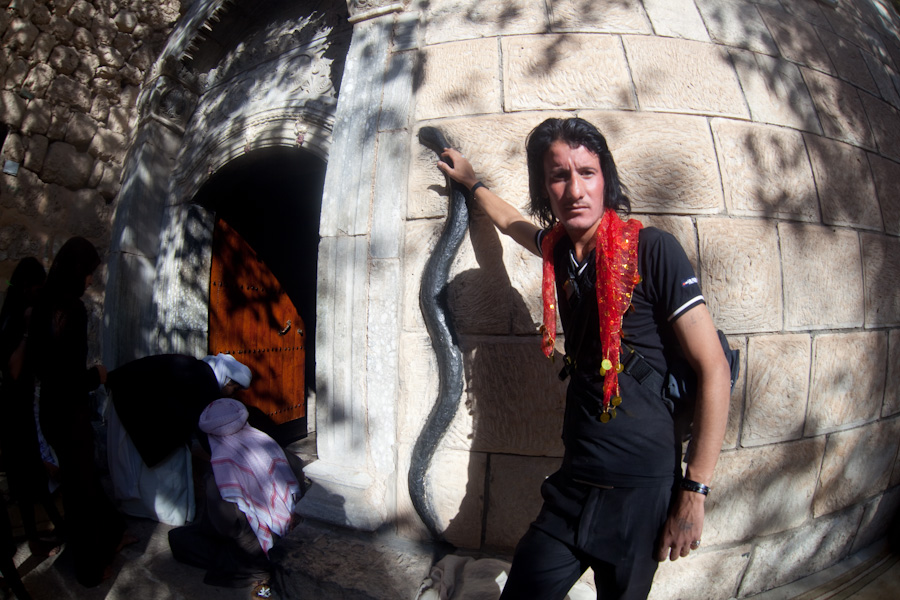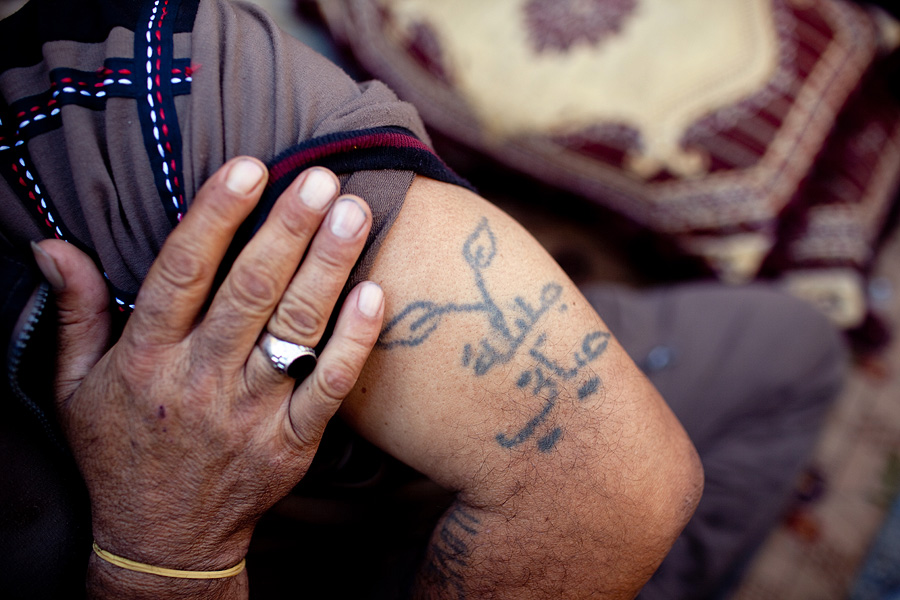They are called devil worshippers, satanists. People of the Book who dominate Middle East have little understanding for ancient beliefs that have been preserved here and in couple of other places in Central Asia, that are living link to ancient Iranian religions, and back to shamanic understanding of nature, link that enables us to discover common Indo- European heritage, and even more than that.
***
Nazywają ich czcicielami diabła, satanistami. Ludzie Ksiegi , którzy kontrolują Bliski Wschód, uznając swe własne mitologie za jedynie słuszne, niewiele mają zrozumienia dla pradawnych wierzeń które przetrwały tutaj, w północnym Iraku, jak i paru innych miejscach środkowej Azji, wierzeń które są żywym reliktem starych irańskich religii a może przede wszystkim szamańskiego postrzegania świata, wierzeń które pozwalają nam zrozumieć wspólne indoeuropejskie dziedzictwo, a może i o wiele więcej.
The central figure for Yazidi is Melek Taus, or Peacock Angel, or , as fanatic adherents of the word of their Book see him, the Fallen Angel. But it represents much more than just The Villain from the story that has been modified so many times anyway. The bird, and the snake, those symbols so closely related, from Quetzalcoatl in Americas to Murugan in India can actually be understood as very creators and essence of life.
In the Gnostic tradition (which the Yezidi religion is closely aligned with), Tawsi Melek is analogous to the first son of the Goddess Sophia, who in the process of creating and governing the universe divided herself into seven rays or “sons.” Her seven sons were coeval with and governed one of the seven colors, tones, planets, etc. The first ray or son, who for the Yezidis was Tawsi Melek (the Ildabaoth of the Gnostics), became the leader of the other sons and the eventual ruler of the universe.
Through his manifestation as a snake, the Peacock Angel is also analogous with the Gnostics’ understanding of the Serpent on the Tree in the Garden of Eden. As opposed to the Christian viewpoint, the Gnostics recognize the Serpent of Eden to be their primal instructor and savior. They claim that the Serpent was specially sent down from Heaven to the Garden of Eden by Sophia in order to help awaken Adam and Eve to their divine nature. According to the perspective of the gnostic yogis of India, the Serpent on the Tree is a metaphor for the inner serpent (known in the East as Kundalini) that coils around the Tree of Life, the human spine, and brings a seeker knowledge of his or her divine nature as it climbs up the tree and awakens the inner centers of gnostic wisdom, the chakras.
***
Centralną postacią dla Jazydów jest Melek Taus, Anioł Paw, lub też jak fanatyczni wyznawcy religii Ksiegi go postrzegają , Upadły Anioł. Ale Melek Taus reprezentuje o wiele więcej niż tylko czarny charakter z tak często modyfikowanej i manipulowanej biblijnej historii. Ptak i wąż, te dwa ściśle związane ze sobą symbole, od Pierzastego Węża, Quetzalcoatla, po Murugana z Indii mogą być odczytane jako właściwi stwórcy, esencja życia.
W tradycji gnostyckiej ( z którą historia wierzeń Jazydów jest ściśle związana ), Tawsi Melek odpowiada pierwszemu synowi boginii Sophii, która podczas tworzenia i uporządkowywania wszechświata podzieliła się na siedem promieni, czy też “synów”. Siedmiu tychże synów było rówieśnikami, i każdy z nich odpowiadał za jeden z siedmiu kolorów, odcieni , planet. Pierworodny, Ildabaoth dla gnostyków , Tawsi Melek dla Jazydów stał się przywódcą pozostałych i ostatecznie właściwym zarządcą wszechświata.
W swoim wcieleniu jako wąż , Anioł Paw odpowiada gnostyckiemu rozumieniu pierwotnego węża z drzewa w ogrodzie Eden. Odwrotnie niż w chrześcijańskiej interpretacji, dla gnostyków Wąż z Edenu to nauczyciel i zbawca. Uważają, że wąż został zesłany z nieba do ogrodu przez Sophię, w celu przebudzenia w Adamie i Ewie świadomości ich boskiej natury. Zgodnie z poglądem gnostyków z Indii, Wąż z Drzewa jest metaforą wewnętrznego węża ( znanego na Wschodzie jako Kundalini ) , który oplata Drzewo Życia, ludzki rdzeń kręgowy, i przynosi poszukującemu wiedze o jego boskiej naturze, poprzez wspinaczkę po drzewie i budzenie wewnętrznych centr gnostyckiej wiedzy, czakr.
In the religion of Sumeria the Peacock Angel was manifest as Enki, the Lord of the Earth, who was also the Lord of Wisdom and the Serpent on the Tree of Dilman, the Sumerian Eden. The Sumerians may have adopted Enki from Yezidi emissaries from India who played a role in the fledgling Sumerian civilization. Or they may have received him from the gnostic sect of Mandeans who were also assimilated into Sumerian civilization after migrating from the East, specifically Sri Lanka, the island patronized by the Peacock Angel as the Hindu Murugan or Sanat Kumara.
Since the Yezidis originated in India, the Hindus’ manifestation of Tawsi Melek is naturally very close to the Peacock Angel of the Yezidis.
The Hindus know Tawsi Melek as Murugan, the legendary son of Shiva and Shakti. Among his numerous alternate titles are Skanda, Sanat Kumara, Karttikeya, and Subramaniya Swami. Like the Yezidis Tawsi Melek, the Hindu Murugan is the king of the universe and moves through his domain as a young boy astride a peacock, or simply as a peacock. Similar to the Peacock Angel, Murugan’s sacred animals include not only the peacock but also the snake and the cock. The snake denotes that the essence of Murugan is pure energy (energy moves as a serpent spiral) and the cock denotes his affiliation as a solar deity. Murugan or Tawsi Melek are names for the cosmic energy that created the universe out of itself, as well as the savior who, like the cock, heralds the end of humanity’s darkness.
Murugan’s identity as one of seven angelic beings is manifest within some Hindu scriptures that refer to him as Sanat Kumara, the leader of the Seven Kumaras. These Kumaras are portrayed as brothers who assisted Sanat Kumara in the creation of the Earth and the enlightenment of humankind. According to the Puranas, the ancient legends of India, the Kumaras were the first to teach humanity the path to enlightenment.
***
W religii Sumerii Anioł Paw objawiał się jako Enki, Władca Ziemi, a także Pan Wiedzy i Wąż na Drzewie w Dilman, sumeryjskim prototypie ogrodu Eden. Sumeryjczycy mogli przejąć postać Enki od wysłanników indyjskich Jazydów, którzy odegrali ważną rolę we wczesnym okresie rozwoju sumeryjskiej kultury. Mogli też przejąć ten koncept od gnostyckiej sekty Mandejczyków których również wchłonęła sumeryjska cywilizacja, po migracjach ze Wschodu, zwłaszcza Sri Lanki, wyspy której patronem jest właśnie Anioł Paw, zwany przez Hindusów Muruganem czy też Sanat Kumara.
Ponieważ korzenie Jazydów siegają Indii, tamtejsze oblicze Tawsi Meleka jest bardzo podobne do tego jak widzą Anioła Pawia iraccy Jazydzi.
Dla Hindusów to Murugan, legendarny syn Sziwy i Szakti. Jego inne tytuły to Skanda, Sanat Kumara, Karttikeya oraz Subramaniya Swami. Jak Tawsi Melek dla Jazydów, tak Murugan dla Hindusów jest królem wszechświata, poruszającym się po swym królestwie pod postacią młodego chłopca ujeżdżającego pawia, lub też pod postacią samego pawia. Podobnie jak w wypadku Anioła Pawia, święte zwierzęta – symbole Murugana to nie tylko paw ale także wąż i kogut. Wąż mówi nam o tym że esencją Murugana jest czysta energia ( energia która porusza się wężową spiralą ), zaś kogut oznacza , że jest to bóstwo słoneczne. Murugan, czy też Tawsi Melek są nazwami kosmicznej energii która stworzyła wszechświat sama z siebie, jak i nazwami zbawiciela, który, podobnie jak kogut, obwieszcza dla ludzkości koniec ery ciemności.
Tożsamość Murugana jako jednego z siedmiu anielskich bytów, kolejne podobieństwo z wierzeniami Jazydów czy zoroastrianizmem, jest widoczna w niektórych pismach indyjskiej tradycji, które nazywają go Sanat Kumara, przywódcą Siedmiu Kumarów. Są to bracia którzy wspierali najważniejszego z nich przy tworzeniu świata i przebudzeniu ludzkości. Według Puran, starożytnych legend Indii, Kumarowie po raz pierwszy wskazali ludziom istnienie ścieżki do oświecenia.
Since its inception, the Peacock Angel has been manifest in the Christian religion as the leader of the Seven Archangels, St. Michael, whose earthly reflection is St. George, which is a name for Al-Khadir (which is a Sufi for Tawsi Melek) The color ray associated with both Michael and Tawsi Melek is blue, and like Tawsi Melek’s Hindu manifestation of Karttikeya, the Commander of the Angelic Host, St. Michael serves a similar function in Christianity.
The symbol of the peacock has long been embraced within Christianity. The bird was the original symbol of the Catholic Church (the peacock denoted the many-eyed church) and it was an early symbol of Jesus, denoting the Christ’s resurrection and immortality. Because of these associations to the Christ peacocks were commonly portrayed in medieval paintings hovering around the baby Jesus’s crib. During the time Jesus walked the Earth, and also afterwards, the peacock alternated with the phoenix as the symbol of immortality in both Egypt and the Middle East. It is for this reason that the peacock was associated with the Christian St. Barbara even though she was the patron saint of Heliopolis, the ancient home of the phoenix.
***
Od samego początku historii chrześcijaństwa Anioł Paw był w nim obecny pod postacią przywódcy siedmiu archaniołów, św Michała, którego ziemskim odbiciem jest świety Jerzy, inne imię dla Al – Khadira ( Melek Taus u sufi ). Kolor promienia, jednego z siedmiu, podporządkowany zarówno Michałowi jak i Tawsi Melekowi jest niebieski, i tak jak ten ostatni w tradycji hinduizmu objawia się jako Karttikeya, komendant anielskich hufców, tak też i św. Michał pełni taką funkcję w chrześcijaństwie.
Symbol pawia też był przez chrześcijaństwo od dawna zasymilowany. Ptak ten był pierwotnym symbolem kościoła katolickiego ( paw – znak powszechnego kościoła o wielu oczach ), był to też wczesny symbol Jezusa, wskazujący na jego zmartwychwstanie i nieśmiertelność. Z powodu tych skojarzeń z Chrystusem pawie często portretowano na średniowiecznych malowidłach wokół kołyski Dzieciątka. W czasach obecności Jezusa na ziemi, oraz później, paw konkurował z feniksem jako symbol nieśmiertelności zarówno w Egipcie jak i na całym Bliskim Wschodzie. Z tego właśnie powodu kojarzono go z chrześcijańską świętą Barbarą, mimo iż była przecież patronką Heliopolis, starożytnego miasta w którym królował pogański feniks.
In the Maya tradition the Peacock Angel is known as the spirit of Quetzlcoatl, the “Plumed Serpent.” In the Quiche Maya cosmology found in the Popul Vuh there is a passage very similar to that found in Genesis (and no doubt has the same origin) which states that the Creator moved upon the face of the waters. In Genesis this creator is recognized to be the synthesis of a group of creator spirits (usually counted as seven) known as the Elohim. Similarly, in the Popul Voh the creator is a blue-green plumed serpent, or “Quetzlcoatl,” comprised of seven creator spirits. The plumed or feathered serpent of the Quiche Maya denotes the Son of God who was the union of the primal male (feathers) and female (serpent body) principles which united to produce the middle color of blue-green. This blue-green dragon is, in other cultures, a peacock rather than a dragon. Thus, the blue-green plumed serpent is the Quiche Maya representation of the Yezidis Peacock Angel.
In Maya tradition many enlightened teachers were historically known as Quetzlcoatl because they had evolved themselves to such an extent spiritually that they had become one with the Divine Mind, which the primal serpent was an embodiment of. In fact, the primal serpent was the first form assumed by Spirit during the process of creating the universe and embodied not only his Divine Mind but his infinite power. Then as he precipitated the universe from out of his own power he encoded it with the blueprints contained within his Divine Mind. Today, those enlightened masters in the Quetzlcoatl tradition often reveal their office by wearing a headdress of peacock feathers.
Masters with the insight and power and called dragons or serpent were not just found among the Maya, they were universal. In fact, during what could be called Earth’s “Dragon Age” most great civilizations were governed both spiritually and temporally by priests and priest kings calling themselves dragons or serpents. Lung Dragons ruled China, Serpent Nagas ruled India, Quetzlcoatls ruled Central America, Druid Adders ruled the British Isles, etc. These rulers had awakened the evolutionary serpent force at the base of the spine, which then climbed the inner Tree of Life (the spine) and united their minds with the Divine Mind. When this occurred, these masters also inherited an abundance of supernatural “serpent” power with which to govern their kingdoms.
***
W tradycji Majów Anioł Paw znany jest jako duch Quetzalcoatla, “Pierzastego Węża”. W ich kosmologii jaką znaleźć można w Popol Vuh odkrywamy paragraf bardzo przypominający analogiczny w księdze Genesis, który mówi iż duch Stwórca poruszał sie po powierzchni wód. W Genesis tego stwórcę można rozpoznać jako syntezę grupy duchów sprawczych, zwykle siedmiu, znanych jako Elohim. Podobnie, w Popol Vuh stwórca , wąż o niebiesko – zielonym upierzeniu, Quetzalcoatl, składa się z siedmiu duchów tworzycieli. Pierzasty Wąż Majów oznacza Bożego Syna, unię pierwotnego męskiego ( pióra ) i żeńskiego ( ciało węża ) pierwiastka, połączonych we wspólnym, niebiesko-zielonym kolorze. Ten niebiesko – zielony smok w innych tradycjach, w tym u Jazydów, reprezentowany jest przez pawia.
W tradycji Majów wielu oświeconych nauczycieli nazywano również imieniem Quetzalcoatla ponieważ duchowo rozwinęli się do tego stopnia, iż stali się jednością z Boskim Umysłem, którego ucieleśnieniem jest właśnie pierwotny wąż, pierwotna forma jaką przybrał Duch podczas tworzenia wszechświata, ucieleśnienie nie tylko Boskiego Umysłu ale i nieskończonej mocy. Moc ta pozwoliła stworzyć świat ale jest też w nim zakodowana, boskie stworzenie jako odbicie Boskiego Umysłu. Oświeceni nauczyciele tradycji Quetzalcoatla nawet dziś używają pióropusza z pawich piór jako oznaki swej roli.
Posiadający głęboki wgląd i moc mistrzowie zwani smokami czy też wężami obecni byli nie tylko wśród Majów, to uniwersalny motyw. Podczas okresu który nazwać można by “Smoczą Erą” większość wielkich cywilizacji rządzona była zarówno duchowo jak i dosłownie przez kapłanów i królów-kapłanów zwiących się mianem węży czy smoków. Smoki Lung władały Chinami, Wężowi Naga Indiami, Quetzalcoatl w Ameryce Środkowej, Druidzie Żmije na wyspach Brytyjskich. Ci władcy potrafili przebudzić ewolucyjną wężową siłę drzemiącą u podstawy kręgosłupa, która wspinała się potem po wewnętrznym Drzewie Życia aby połączyć ich umysły w jedność z boskością. Kiedy to następowało, władcy ci obdarzani byli nadzwyczajną wężową siłą, przydatną do rządzenia ich królestwami.
The Peacock Angel was known in Greece and Egypt as Dionysus and Osiris respectively. According to the early Greek historians like Diodorus these figures were manifestations of the same entity in different civilizations.
Osiris, meaning the “Many-eyed,” was a legendary Egyptian king who reflected many of the attributes of the Peacock Angel. After encircling the globe astride a bull he ostensibly became, like Tawsi Melek, King of the World. Like the Peacock Angel, Osiris was also omniscient, or “Many-eyed,” and his eyes multiplied throughout the universe. The symbol of both Tawsi Melek and Osiris is the many-eyed Flower of Life. Osiris was also known in Egypt as the “green man,” and his green image could often be found in the Egyptian temples. Because of this association, Osiris was annually prayed to for the renewal of Egypt’s green vegetation.
The association between Dionysus and Tawsi Melek became conclusive during the conquest of Alexander the Great, when members of the conquerors’ army visited the temples of Murugan in Sri Lanka while exclaiming “We know this deity, he’s our Dionysus.” So sure were they of this truth that when the Greek Ptolemy created the first world map he
labeled Murugan’s region in Sri Lanka the “Place of Bacchus,” or “Place of Dionysus.” Like his Hindu counterpart Murugan, Dionysus was the union of the universal male/female polarity (Zeus and Semele) and the chosen King of the World. Also reflecting both Murugan and Tawsi Melek, Dionysus was in some cosmologies designated the creator of the universe, and wherever his cult flourished he was represented as a snake or serpent, symbol of the life force that condensed to become the physical cosmos. Every year it was believed by the Greeks that Green Man Dionysus as the primal serpent power or life force would awaken from his slumber and their lands would become abundant again.
***
Anioł Paw w Grecji i Egipcie znany był odpowiednio jako Dionizos i Ozyrys. Według wczesnych greckich historyków takich jak Diodorus te postaci były po prostu manifestacjami tego samego konceptu w różnych cywilizacjach.
Ozyrys, co znaczy Ten o Wielu Oczach, był legendarnym egipskim królem o wielu z atrybutów Anioła Pawia. Po okrążeniu kuli ziemskiej na byku, podobnie jak Tawsi Melek, został Królem Świata, podobnie również wszystko widzący, o wielu oczach rozmnożonych po całym wszechświecie. Oboje dzielą wspólny symbol, Kwiat Życia o licznych oczach. Ozyrys znany w Egipcie był również jako “Zielony Człowiek” i jego zielone przedstawienie obecne było często w egipskich świątyniach, gdzie corocznie zanoszono do niego modły o odnowienie życia i roślinnego cyklu.
Z powiązań między Dionizusem i Tawsi Melekiem zdali sobie szybko sprawę członkowie armii Aleksandra Wielkiego, podczas jego podbojów trafili aż na Sri Lankę gdzie w świątyniach Murugana ze zdumieniem wykrzykiwali – “znamy to bóstwo, to nasz Dionizus!” . Byli tego tak pewni że kiedy grecki geograf Ptolemeusz tworzył swą pierwszą mapę świata na miejscu Sri Lanki umieścil jednoznaczny napis – “miejsce Dionizusa”. Tak jak jego hinduski odpowiednik Murugan, czy też Tawsi Melek, Dionizus to jedność dwóch uniwersalnych przeciwieństw, męskiego i żeńskiego ( Zeus i Semele ), i wybrany jest władcą tego świata, jak i w niektórych kosmologiach, jego stworzycielem. Tam gdzie kwitł jego kult, Dionizus przedstawiany był jako wąż, symbol życiowej siły z której zrodził się fizycznie istniejący kosmos. Co roku, jak wierzyli Grecy, Zielony Człowiek, Dionizus, jako ta pierwotna wężowa siła budził się ze snu i świat stawał się na nowo płodny.
The Persian Zoroastrian tradition is a close cousin to that of the Yezidis’ and it is probable that they have a common origin in the East. Links between the Yezidis and Persians are manifold. They share many rites, including daily Sun worship, and the premier savior-deity of both traditions (Mithra and Tawsi Melek) is a solar god possessing the cock as a sacred animal and Sunday as his sacred day of the week. There is no question Tawsi Melek and his Hindu counterpart, Murugan, are counterparts of the Persian Mithra, whose name denotes “middle” and “harmony,” thus denoting the balance and union of the universal polarity that brought both Murugan and the Peacock Angel into manifestation. Mithra’s common name in Persia was Mihr, a title currently assumed by Tawsi Melek’s premier representative on Earth, the Mir or Yezidi Prince, and an additional link between Mithra and Murugan can be gleened from the name of Mithra’s most sacred annual celebration, the Mihragan ( which takes place exactly same time as most important gathering of Yazidis, during which, as in Mithra rituals, focal point is slaying of a bull )
***
Perska, zoroastriańska tradycja to bliska kuzynka Jazydyzmu , o wspólnych, najprawdopodobniej wschodnich korzeniach. Powiązania między Yazydami i Persami są niezliczone, wspólne rytuały, jak na przykład codzienny kult słońca, w obu główne bóstwo – zbawca ( Mitra i Melek Taus ) to słoneczny bóg, symbolizowany przez koguta jako jedno ze swych świętych zwierząt, czczony w niedzielę. Nie ma też wątpliwości że perski Mitra, którego imię oznacza środek i harmonię, jest odpowiednikiem hinduskiego Murugana, jak i Melek Tausa, wszyscy to owoc tej samej unii między uniwersalnymi przeciwieństwami. Powszechnym innym określeniem Mitry w Persji był Mihr, obecnie tytuł jaki nosi pierwszy reprezentant Anioła Pawia na ziemi, Mir, czy też Książe Jazydów. Zdjęcia zamieszczone w tym zestawie pochodzą z dorocznego święta Jazydów odbywającego sie jesienią dokładnie w tym samym czasie co najświętszy festiwal mitraizmu, Mihragan. W obu tych świętach najważniejszym wydarzeniem jest rytualne uśmiercenie byka.
Thus, the connection between Tawsi Melek and Mithra is undeniable, however the Peacock Angel’s most salient Persian counterpart is the primal bird of paradise, the Simurgh, who possesses a dog or dragon head and a huge peacock tail. The Simurgh lives on Mount Elbourz, the
primal sacred mountain at the center of the Earth that serves as an axis mundi uniting Heaven and Earth. Elbourz is, by the way, also said to be the worldly home of Mithra, so perhaps the Simurgh is one of his alternate forms.
The Simurgh was the patron of the lineage of Persian Kings, many of which lived in glorious castles in the Elbourz Mountains in northern Iran. This link was never more evident than during the early Sasanian Dynasty, when the Persian kings adopted the Simurgh as their royal symbol.
According to some Persian legends the Simurgh is, like Tawsi Melek, the Planetary Logos or collective consciousness of all creatures on Earth. This truth is illustrated in an old Persian legend known as The Conference of the Birds, during which a flock of birds paid a visit to the Simurgh at his home on Mt. Elbourz. After having a private meeting with the Simurgh each of the birds spoke amongst themselves about their experience. Each shared that gazing at the Simurgh was like looking into a mirror. Each bird saw himself reflected back to him because the Simurgh is the union of them all.
Also reflecting the Peacock Angel, the Simurgh serves the function of the “Green Man,” albeit indirectly. The association can be deduced through the name Simurgh, which is a contraction Saena meregh, meaning the “Saena bird.” In Persian legend it was said that as the Saena bird the Simurgh lived upon the Saena Tree, the world tree, which flourished upon an island in the middle of a cosmic sea known as Lake Vourukasha. Occasionally the Saena bird would flap its wings and spread seeds all over the Earth. These seeds would sprout to become the green vegetation that covered the planet.
***
Jedność Melek Tausa i Mitry jest niepodważalna, ale najbardzie wyrazistym odpowiednikiem Anioła Pawia w tradycji perskiej będzie chyba pierwotny rajski ptak, Simurgh, posiadający psią głowę i ogromny pawi ogon. Żyje on na górze Elbourz, świetej górze w centrum świata, pełniącej funkcję uniwersalnej Osi Świata, łączącej Niebo i Ziemię. Elbourz jest jednocześnie ziemskim domem Mitry, co sugeruje że Simurgh jest jedną z jego form.
Ptak Simurgh był patronem dynastii perskich władców, z których wielu żyło we wspaniałych zamkach w górach Elbourz w dzisiejszym północnym Iranie, zwłaszcza Sassanidów którzy używali go jako swego królewskiego symbolu.
Według niektórych perskich legend Simurgh, jak Tawsi Melek, to planetarny logos, kolektywna świadomość wszystkich istnień na ziemi. O tej prawdzie opowiada znana , stara legenda o Konferencji Ptaków, na którą udaje się stado ptaków, chcących odwiedzić Simurgha w jego domu na górze Elbourz. Po wielu przeciwnościach docierają na miejsce, i tam , po prywatnej audiencji rozmawiają o swym doświadczeniu. Okazuje się, że każdy patrząc na Simurgha widział sam siebie, bo Simurg jest połączeniem ich wszystkich.
Podobnie jak w przypadku Anioła Pawia, Simurgh pośrednio spełnia funkcję Zielonego Człowieka. Można odczytać to z korzeni jego imienia, będącego skrótem od “Saena meregh”, czyli ptak Saena. Według innej perskiej legendy to ptak żyjący na drzewie Saena, Drzewie Świata, wyrastającym z wyspy na kosmicznym jeziorze Vourukasha. Od czasu do czasu ptak Saena rozpościerał swe skrzydła rozrzucając po całej ziemi nasiona, źródło życia, i zielonej roślinności pokrywającej planetę.
na podstawie / based on
yeziditruth.org










